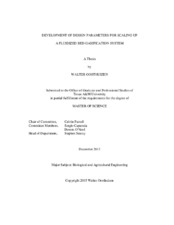| dc.description.abstract | Cotton gins across the globe accumulate cotton gin trash (CGT) as a byproduct from the ginning process. CGT is typically viewed as a waste product, however, it is a biomass that has an energy content of around 15.5 MJ kg^-1. The energy from the CGT can be converted to useful energy through fluidized bed gasification (FBG), which is a thermo-chemical process that converts a biomass into a combustible synthesis gas (syngas). The syngas can be combusted in an internal combustion engine to generate electricity.
Ambient air fluidization tests were conducted to validate a model to predict the minimum fluidization velocity (MFV) at hot, operating conditions of the gasifier. The average measured and the theoretical MFV at ambient conditions were found to be 56.0 and 63.5 cm s^-1, respectively. The percent error between the actual and theoretical MFV values at ambient conditions was 11.8%.
A tube cyclone was designed using the Texas A&M cyclone design (TCD) method and was implemented into the gasification system to partially separate the biochar from the syngas. The vortex inverter position within the cyclone and the flow rate of air were varied to determine the effect on capture efficiency. Capture efficiencies at ambient conditions ranged between 95% and 99%. The p-value of the tested flow rate and vortex inverter positions were 0.058 and 0.118, respectively, and had an insignificant effect on the capture efficiency of the cyclone. The estimated capture efficiency during gasification was deemed inconclusive and that additional research was needed to obtain an accurate efficiency.
The energy loading (EL) and fuel to air (F/A) ratio were the two operating parameters used when conducting gasification tests on a 0.15 m diameter gasifier. Lower heating values (LHV) of the syngas ranged between 5.25 and 2.76 MJ Nm^-3 at F/A ratios of 0.6 and 0.96 kgfuel/kgair, respectively. At an optimum combination of EL of 17.0 GJ h-1 m-2 and a F/A ratio of 0.7 kgfuel/kgair, the average LHV of the syngas was approximately 4.72 MJ Nm-3 at an average reaction temperature of 700°C. The conversion of fuel to syngas by mass and energy were 39% and 38%, respectively.
The syngas produced from the FBG system was partially directed to a 4 kW generator during gasification. The engine of the generator was successfully fueled solely by syngas, which validated the concept that the pilot scale FBG system can be scaled up to generate 500 kW of electricity. | en |


